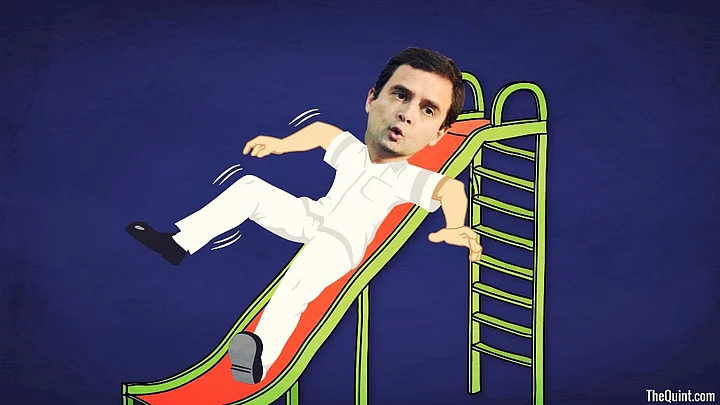An IndiaSpend article shows that “Congress is not doing as badly as it seems”. This, however, would not have brought any cheer to the party leadership and its hardcore supporters.The fact is that Congress’ poor performance continued in 15 states which went to the polls after the 2014 Lok Sabha elections. In 11 of these 15 states, the party lost vote share vis-à-vis parliamentary elections.
The Gradual Decline
The Congress gained vote share only in Assam, Tamil Nadu, West Bengal and Punjab. Of these, it lost Assam while it gained Punjab.
On a weighted average basis, the Congress recorded 16.6 percent vote share in 2014 in these 15 states. This reduced to 15.7 percent in subsequent assembly polls. The party lost state assemblies in eight states (including allies) – Maharashtra, Haryana, Jammu & Kashmir, Jharkhand, Uttarakhand, Assam, Manipur and Kerala.
It could gain power only in Punjab and Bihar as a junior partner. The BJP too, lost vote share across these states. It is down from 27.8 percent in 2014 to 24 percent in assembly elections that followed.
However, the decline is not being captured by the Congress, but by the regional parties. One may argue that what should be looked at is the vote share of a party only in seats where it contested (contested vote share).
In UP, the Congress contested only in 100 odd seats and received 22.2 percent of the popular vote. This is an improvement over the 9 percent vote share it secured in the 2014 Lok Sabha elections when it contested 67/80 seats in alliance with the RLD. The contested vote share is more relevant for regional parties if the Congress wants to call itself that. The argument then just stops here.
The other way to look at vote shares is to compare the combined vote share of the Congress alliance (UPA) in 2014 versus subsequent state polls. The Congress allied with JDU and RJD in Bihar, the SP in UP, the Left Front in West Bengal and the DMK in Tamil Nadu. In three of four states, the Congress/UPA lost vote share except in Tamil Nadu.
A Silver Lining for the Party?
The 813 MLAs the Congress commands is the lowest in its entire political history. It accounts for less than 20 percent of MLAs today. Even during the Janata Party regime, it had 25 percent MLAs and during the previous NDA government led by AB Vajpayee, the Congress’ had 22 percent legislators. The BJP has close to 1,400 MLAs – its highest tally – accounting for 34 percent of its total strength.
Resultantly, the percentage of Congress-ruled states is at its lowest at 19 percent.
But there is a silver lining for the sinking party. The Congress’ seat tally has increased from 276 to 342. This is primarily on account of Bihar and West Bengal where it formed an alliance with the JD(U) and the Left. In Bihar, it gained 13 and in West Bengal 16 seats. The alliance with the Left parties is already in doldrums. It remains to be seen how long the partnership with the JD(U) continues. Punjab, where the Congress managed to form government, gave it an additional 40 seats.
What the Congress Needs to Do
However, it’s important to note that the party had won 478 seats in these 15 seats in the previous assembly elections.
It’s very natural for a party, which was victorious in the Lok Sabha, to lose some votes in the range of 15-25 percent in assembly elections due to local factors dominating those states. A big worry for the Congress is that the decline in BJP votes is being captured by regional parties. The Congress is staring at a situation during 1950-1990 when it was the pole party with the opposition constituting numerous regional parties. Now the BJP has occupied the pole position and the Congress is restricted to just six states.
If the Congress seeks to remain in electoral contention, it should:
- Nurture strong leaders
- Decide on clear leadership in states
- Discourage factionalism
(The author is an independent political commentator and can be reached at @politicalbaaba. The views expressed above are the author’s own. The Quint neither endorses nor is responsible for the same.)
(At The Quint, we question everything. Play an active role in shaping our journalism by becoming a member today.)
